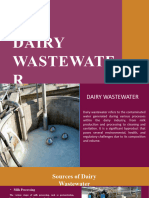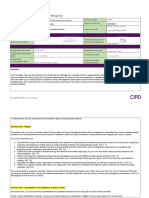Assignment 01
Uploaded by
Praful N KAssignment 01
Uploaded by
Praful N KASSIGNMENT 01
COURSE: Modelling Watershed Processes for Water Resource
Management
NAME OF PARTICIPANT: PRAFUL N K
Watershed Management in Highlands of Ethiopia: A Review
Watershed is not only the hydrological unit it is also socio-political-ecological entity which
plays a decisive role in determining socio-economic security and it helps to support the
livelihood of the community. Since the economy of Ethiopia is agrarian in nature, the decline
in agricultural productivity adversely affects the economic growth of the country. Literatures
reveal that Ethiopian highlands are seriously eroded and becoming unsuitable to cultivation.
The objective of this study is to review the problems and solution of watershed in Ethiopia to
ameliorate the situation. The participatory watershed management approach started yielding
positive result when some of the shortcoming was removed through the instrument of new
policies. The long-term community based participatory watershed management could be an
appropriate vehicle for improvement of living conditions of rural communities
In recent years Ethiopia has had severe land degradation, soil erosion, and deforestation of
natural resources, desertification is a new normal in the country. The highlands constituting the
majority of land is currently under stress due to rising population pressure and their
conservative socioeconomic practices. Average soil loss from cultivated land varied from 21
to 42 t/ha/year. The magnitude soil loss in Ethiopian highland from different categories of land
use is estimated to be 1863.6 mt/year. Of this enormous soil loss, about 90% is deposited in the
valley and the remaining 10% is transported with water to Egypt.
The degradation of agricultural land in high mountains is a serious risk to food production
in Ethiopia. The following are the major reason for Land degradation: a] Weather Condition,
b] Population pressure, c] Poor infrastructure d] Poverty and e] Lack of awareness.
Consequence of Natural Resource Degradation:
Loss in water resource: The decrease in forest resources resulted in increased surface runoff
that silted up different water storage structures. As a result, there is shortage water even for
drinking by animal and human
Loss of livestock production: Natural resource degradation has aggravated both the quality
and quantity of livestock production due to shortage of fodder.
Unemployment and rural-urban migration: In the degraded areas, production of crop and
livestock is drastically reduced and the area is unable to support the population. The reduced
farm activities reduce the opportunity of farm employment therefore migration of rural people
to urban areas is increased.
Food insecurity and incidence of drought: More than 85% of Population is dependent on
agriculture. Degraded watersheds are unable to support the rural population causing food
insecurity under recurring drought situations.
Measures Taken to Control Degradation in Ethiopia
Starting from the 1970s and onward, huge areas have been taken under soil and water
conservation activities, and millions of indigenous tree species were planted, through
community participation covering huge areas by trees, forest and community woodlots. The
Food for work project funded by the World Food Program was implemented with the objectives
to employ a labour force of the farmers to participate into the plantation, soil and water
conservation activities in lieu of food grain and edible oil. In 1980-90, the government
implemented rehabilitation of natural resources in Ethiopia through watershed development
and management on pilot basis with the support of FAO. The project used the sub-watershed
as the unit area for planning and management involving the participation of local people. This
was the initial stage in the evolution of the participatory planning approach to watershed
development.
In 1991, the Ethiopian government designed a new economic policy based on Agricultural
Development-Led Industrialization. Natural resource conservation-based agriculture
development became the primary objectives of industries. Industries gave impetus to
improved watershed management adopting, different soil and water conservation practices,
and rehabilitation of watershed through afforestation, community woodlots development and
construction of micro and small scale irrigation projects. The Land tenure certification
encourages farmers to invest in long-term soil and water conservation activities, to obtain
credits, to adopt intensive farming practices and to make sustainable use of watershed lands
and manage soil erosion in fields.
The watershed management practices also played a crucial role in arresting runoff and helping
to reduce erosion hazard. In view of that at the pilot watershed level a total of 297 km hillside,
27,783 trenches, 446 m3 Gabion, 3167 m3 stone check dam, and 854 m3 sediment storage, 586
m3 gully rehabilitation/re-vegetation, 80 ha bund stabilization, 25 km construction of recharge
pits have been constructed over the degraded hillsides. Due to the positive impact of watershed
management practice, recently there are attitudinal changes within the community. And it is
facilitating role of the community-based watershed management organization, community
participate 30 - 40 percent free labour for watershed management practice in the country
Conclusion:
The participatory watershed management approach started yielding positive results. The
shortcoming was removed through the instrument of new policies and long-term community
based participatory watershed management could be an appropriate vehicle for improvement
of living conditions of rural communities.
References:
[1] T.Worku , S.Tripathi Bekele-Tesemma, “Watershed Management in Highlands of Ethiopia:
A Review”. OALib , Vol. 02(06), Pg.1-11, 2015.
You might also like
- Chris Brogan-Social Media 101 - Tactics and Tips To Develop Your Business Online (2010)No ratings yetChris Brogan-Social Media 101 - Tactics and Tips To Develop Your Business Online (2010)9 pages
- Agricultural Water Management: Technology Options and Adoption Under Hydro Climatic Constraint. The Case of Halaba Special WoredaNo ratings yetAgricultural Water Management: Technology Options and Adoption Under Hydro Climatic Constraint. The Case of Halaba Special Woreda8 pages
- Upper Breede Collaborative Extension Group (UBCEG) Overview 2006 - 2009No ratings yetUpper Breede Collaborative Extension Group (UBCEG) Overview 2006 - 200916 pages
- Attachment Fodder Material For NABARD Grade A B Batch 1 Lyst8252No ratings yetAttachment Fodder Material For NABARD Grade A B Batch 1 Lyst825217 pages
- Land Degradation: Soils Water Resources Forests Grass Lands Crop Lands (Rainfed, Irrigated) BiodiversityNo ratings yetLand Degradation: Soils Water Resources Forests Grass Lands Crop Lands (Rainfed, Irrigated) Biodiversity38 pages
- Soil_and_Water_Conservation_Nexus_Agricultural_ProNo ratings yetSoil_and_Water_Conservation_Nexus_Agricultural_Pro10 pages
- Rainwater Harvesting and Integrated Development of Agri-Horti-Livestock-CumpiscicultureNo ratings yetRainwater Harvesting and Integrated Development of Agri-Horti-Livestock-Cumpisciculture7 pages
- CARBONEL-LAB6-Ntroduction To Irrigation and Drainage - AENGR 1105No ratings yetCARBONEL-LAB6-Ntroduction To Irrigation and Drainage - AENGR 11054 pages
- Review of Irrigation Development in Kenya: BackgroundNo ratings yetReview of Irrigation Development in Kenya: Background20 pages
- Land Degradation and Integrated Watershed Management in IndiaNo ratings yetLand Degradation and Integrated Watershed Management in India9 pages
- Innovative Technologies For Water Saving in Irriga PDFNo ratings yetInnovative Technologies For Water Saving in Irriga PDF7 pages
- Innovative Technologies For Water Saving in Irriga PDFNo ratings yetInnovative Technologies For Water Saving in Irriga PDF7 pages
- Ambo University School of Civil and Environmental Engineering100% (1)Ambo University School of Civil and Environmental Engineering23 pages
- Innovative Technologies For Water Saving in Irrigated AgricultureNo ratings yetInnovative Technologies For Water Saving in Irrigated Agriculture6 pages
- The Importance of Water Conservation in the 21st CenturyNo ratings yetThe Importance of Water Conservation in the 21st Century2 pages
- National Agriculture Policy Ministry of Agriculture, Department of Agriculture & Co-Operation, Government ofNo ratings yetNational Agriculture Policy Ministry of Agriculture, Department of Agriculture & Co-Operation, Government of12 pages
- Time Series Analysis I: Discussion Questions - These Will Be Covered in The Quick QuizNo ratings yetTime Series Analysis I: Discussion Questions - These Will Be Covered in The Quick Quiz7 pages
- Ground Floor: Proposed Estimate For The Proposed Construction of Residential G.F. & F.F. Building in CtsNo ratings yetGround Floor: Proposed Estimate For The Proposed Construction of Residential G.F. & F.F. Building in Cts18 pages
- GMPGMPH Ma MC Me Meh MK MM MMH Mu Opn Rc2 Rc3 Rc4 Rc5 Rc6 Rc7 Rc8 Rc9 College Code & NameNo ratings yetGMPGMPH Ma MC Me Meh MK MM MMH Mu Opn Rc2 Rc3 Rc4 Rc5 Rc6 Rc7 Rc8 Rc9 College Code & Name1 page
- Institute Name: Karnataka University (IR-O-U-0230)No ratings yetInstitute Name: Karnataka University (IR-O-U-0230)16 pages
- Application Acknowledgment: The Collector, Office of District Collectorate (DISTRICT - TENKASI)No ratings yetApplication Acknowledgment: The Collector, Office of District Collectorate (DISTRICT - TENKASI)1 page
- BMRCL, R5P1 Lock Down Attendance: Q QuarantineNo ratings yetBMRCL, R5P1 Lock Down Attendance: Q Quarantine1 page
- S.No Location Description Date Status of NCR (Open/Closed) If Closed, Date Report No. R5-P1 Sor SummaryNo ratings yetS.No Location Description Date Status of NCR (Open/Closed) If Closed, Date Report No. R5-P1 Sor Summary1 page
- Project Report: Model File: Structure01, Revision 0No ratings yetProject Report: Model File: Structure01, Revision 090 pages
- M/S ..Civil Engineer Fieldwork Expert Project .. Engineer Tower City Center, GwaliorNo ratings yetM/S ..Civil Engineer Fieldwork Expert Project .. Engineer Tower City Center, Gwalior1 page
- Achievement Achievement Achievement Achievement AchievementNo ratings yetAchievement Achievement Achievement Achievement Achievement1 page
- TB2-SDC - VPM210171-00100-M-M1B-PFD-0001 Rev0No ratings yetTB2-SDC - VPM210171-00100-M-M1B-PFD-0001 Rev023 pages
- Agri Market Brief 19 Organic Imports - enNo ratings yetAgri Market Brief 19 Organic Imports - en19 pages
- F5 Solutions Playbook September 2016 PDFNo ratings yetF5 Solutions Playbook September 2016 PDF92 pages
- Operating Manual: Electric Dust CatcherNo ratings yetOperating Manual: Electric Dust Catcher25 pages
- Systems Analysis and Design in a Changing World 7th Edition Satzinger Solutions Manual - Free Download Available To Read All Chapters100% (1)Systems Analysis and Design in a Changing World 7th Edition Satzinger Solutions Manual - Free Download Available To Read All Chapters24 pages
- Technical Analysis: DR - Manish Dadhich Mba, Net, SetNo ratings yetTechnical Analysis: DR - Manish Dadhich Mba, Net, Set51 pages
- Cellulolytic Fruits Wastes: A Potential Support For Enzyme Assisted Protein ProductionNo ratings yetCellulolytic Fruits Wastes: A Potential Support For Enzyme Assisted Protein Production9 pages
- Free Access to Test Bank for Guide to Firewalls and VPNs, 3rd Edition Chapter Answers100% (6)Free Access to Test Bank for Guide to Firewalls and VPNs, 3rd Edition Chapter Answers30 pages
- Características de Compactación de La Arcilla de Bangkok Estabilizada Con Cenizas de Cáscara de Arroz, Cenizas de Fondo y CalNo ratings yetCaracterísticas de Compactación de La Arcilla de Bangkok Estabilizada Con Cenizas de Cáscara de Arroz, Cenizas de Fondo y Cal8 pages
- Analisis Tingkat Kesehatan Bank Dengan Menggunakan Metode Risk Profile, Good Corporate Governance, Earning, Capital (RGEC)No ratings yetAnalisis Tingkat Kesehatan Bank Dengan Menggunakan Metode Risk Profile, Good Corporate Governance, Earning, Capital (RGEC)16 pages
- Lindsay Anton - The Final Paper - 2956488No ratings yetLindsay Anton - The Final Paper - 295648821 pages
- 5CO02 - 20s-Khalid Qasem - AR1 Report - V2No ratings yet5CO02 - 20s-Khalid Qasem - AR1 Report - V29 pages
- ACT 203 Cost Accounting: 04/05/2023 B Com (Finance/ Accounting), RTC, ThimphuNo ratings yetACT 203 Cost Accounting: 04/05/2023 B Com (Finance/ Accounting), RTC, Thimphu35 pages
- Chris Brogan-Social Media 101 - Tactics and Tips To Develop Your Business Online (2010)Chris Brogan-Social Media 101 - Tactics and Tips To Develop Your Business Online (2010)
- Agricultural Water Management: Technology Options and Adoption Under Hydro Climatic Constraint. The Case of Halaba Special WoredaAgricultural Water Management: Technology Options and Adoption Under Hydro Climatic Constraint. The Case of Halaba Special Woreda
- Upper Breede Collaborative Extension Group (UBCEG) Overview 2006 - 2009Upper Breede Collaborative Extension Group (UBCEG) Overview 2006 - 2009
- Attachment Fodder Material For NABARD Grade A B Batch 1 Lyst8252Attachment Fodder Material For NABARD Grade A B Batch 1 Lyst8252
- Land Degradation: Soils Water Resources Forests Grass Lands Crop Lands (Rainfed, Irrigated) BiodiversityLand Degradation: Soils Water Resources Forests Grass Lands Crop Lands (Rainfed, Irrigated) Biodiversity
- Soil_and_Water_Conservation_Nexus_Agricultural_ProSoil_and_Water_Conservation_Nexus_Agricultural_Pro
- Rainwater Harvesting and Integrated Development of Agri-Horti-Livestock-CumpiscicultureRainwater Harvesting and Integrated Development of Agri-Horti-Livestock-Cumpisciculture
- CARBONEL-LAB6-Ntroduction To Irrigation and Drainage - AENGR 1105CARBONEL-LAB6-Ntroduction To Irrigation and Drainage - AENGR 1105
- Review of Irrigation Development in Kenya: BackgroundReview of Irrigation Development in Kenya: Background
- Land Degradation and Integrated Watershed Management in IndiaLand Degradation and Integrated Watershed Management in India
- Innovative Technologies For Water Saving in Irriga PDFInnovative Technologies For Water Saving in Irriga PDF
- Innovative Technologies For Water Saving in Irriga PDFInnovative Technologies For Water Saving in Irriga PDF
- Ambo University School of Civil and Environmental EngineeringAmbo University School of Civil and Environmental Engineering
- Innovative Technologies For Water Saving in Irrigated AgricultureInnovative Technologies For Water Saving in Irrigated Agriculture
- The Importance of Water Conservation in the 21st CenturyThe Importance of Water Conservation in the 21st Century
- National Agriculture Policy Ministry of Agriculture, Department of Agriculture & Co-Operation, Government ofNational Agriculture Policy Ministry of Agriculture, Department of Agriculture & Co-Operation, Government of
- Time Series Analysis I: Discussion Questions - These Will Be Covered in The Quick QuizTime Series Analysis I: Discussion Questions - These Will Be Covered in The Quick Quiz
- Ground Floor: Proposed Estimate For The Proposed Construction of Residential G.F. & F.F. Building in CtsGround Floor: Proposed Estimate For The Proposed Construction of Residential G.F. & F.F. Building in Cts
- GMPGMPH Ma MC Me Meh MK MM MMH Mu Opn Rc2 Rc3 Rc4 Rc5 Rc6 Rc7 Rc8 Rc9 College Code & NameGMPGMPH Ma MC Me Meh MK MM MMH Mu Opn Rc2 Rc3 Rc4 Rc5 Rc6 Rc7 Rc8 Rc9 College Code & Name
- Institute Name: Karnataka University (IR-O-U-0230)Institute Name: Karnataka University (IR-O-U-0230)
- Application Acknowledgment: The Collector, Office of District Collectorate (DISTRICT - TENKASI)Application Acknowledgment: The Collector, Office of District Collectorate (DISTRICT - TENKASI)
- S.No Location Description Date Status of NCR (Open/Closed) If Closed, Date Report No. R5-P1 Sor SummaryS.No Location Description Date Status of NCR (Open/Closed) If Closed, Date Report No. R5-P1 Sor Summary
- Project Report: Model File: Structure01, Revision 0Project Report: Model File: Structure01, Revision 0
- M/S ..Civil Engineer Fieldwork Expert Project .. Engineer Tower City Center, GwaliorM/S ..Civil Engineer Fieldwork Expert Project .. Engineer Tower City Center, Gwalior
- Achievement Achievement Achievement Achievement AchievementAchievement Achievement Achievement Achievement Achievement
- Systems Analysis and Design in a Changing World 7th Edition Satzinger Solutions Manual - Free Download Available To Read All ChaptersSystems Analysis and Design in a Changing World 7th Edition Satzinger Solutions Manual - Free Download Available To Read All Chapters
- Technical Analysis: DR - Manish Dadhich Mba, Net, SetTechnical Analysis: DR - Manish Dadhich Mba, Net, Set
- Cellulolytic Fruits Wastes: A Potential Support For Enzyme Assisted Protein ProductionCellulolytic Fruits Wastes: A Potential Support For Enzyme Assisted Protein Production
- Free Access to Test Bank for Guide to Firewalls and VPNs, 3rd Edition Chapter AnswersFree Access to Test Bank for Guide to Firewalls and VPNs, 3rd Edition Chapter Answers
- Características de Compactación de La Arcilla de Bangkok Estabilizada Con Cenizas de Cáscara de Arroz, Cenizas de Fondo y CalCaracterísticas de Compactación de La Arcilla de Bangkok Estabilizada Con Cenizas de Cáscara de Arroz, Cenizas de Fondo y Cal
- Analisis Tingkat Kesehatan Bank Dengan Menggunakan Metode Risk Profile, Good Corporate Governance, Earning, Capital (RGEC)Analisis Tingkat Kesehatan Bank Dengan Menggunakan Metode Risk Profile, Good Corporate Governance, Earning, Capital (RGEC)
- ACT 203 Cost Accounting: 04/05/2023 B Com (Finance/ Accounting), RTC, ThimphuACT 203 Cost Accounting: 04/05/2023 B Com (Finance/ Accounting), RTC, Thimphu















































































































